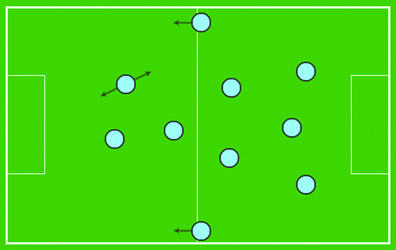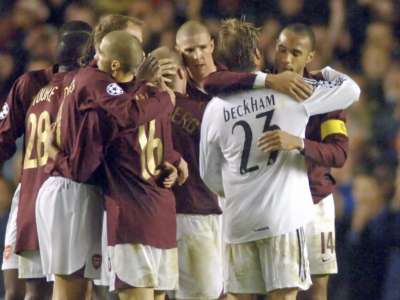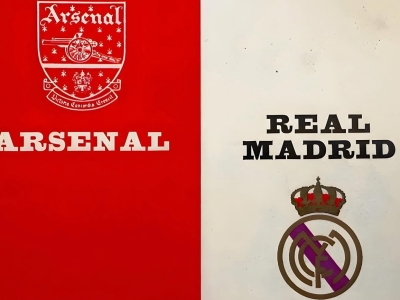(Ed’s note - In Issue 262 of The Gooner last season, published in November, after Chelsea had switched to three at the back, we ran an article by Simon Rose pondering whether Arsenal could adapt to the same formation. With the change actually taking place some five months later, we’re running the piece online to see how the idea compared to the reality.)
Chelsea will win the league this season, because they have devised a ground-breaking 3-4-3 formation which has instantly left rivals floundering in their wake. That sums up the current perceived media wisdom, anyway. When a new football fad is pioneered, rivals are immediately floored for a while until they feel compelled to hijack the bandwagon, or pretend that they were on it too. Coaches don’t like to appear usurped, or for it to seem that a peer has conceived something fresh and inspired. Some claim they had been thinking of doing that new thing anyway and others posture that they had done it before, so they’re not really copying anyone. But plagiarism has long been rife in football, be it formations, terrace songs or goal celebrations. Suddenly, 3-4-3 has become the celebrated formation du jour for football hipsters. Could Arsenal play 3-4-3?
Few football formations are new, of course, and 3-4-3 has been tried before, plus the slightly more conservative 3-5-2, but other formations have been the accepted best practice of the day. For years, 4-4-2 was the universally-approved formation. The idea of two main strikers has become devalued, in favour of variations based around one striker. Unconvinced 3-4-3 will catch on? Well, 4-5-1 became the global norm, plus its variations, like 4-3-2-1 and 4-1-4-1, but perhaps that fascination is wearing thin. Chelsea opted for a back three after we dismembered them 3-0 and the formation has been serving them tremendously well ever since, with five successive league wins and no goals conceded. But is 3-4-3 a viable long-term strategy, or a sticking plaster to heal wounds? Do Chelsea intend to stay faithful for the foreseeable future, as if they have struck on a rare winning formula before others can suss it fully (like Leicester did last season), or would they drop 3-4-3 like a stone if some results went amiss? Do the benefits of 3-4-3 outweigh its limitations?
The main benefit is an extra body in midfield, for a front seven, rather than a front six offered by 4-4-2 or 4-5-1. That offers a dual purpose: an extra person to boost attacks when going forward and an extra body to shield the defence when on the back foot. It could be overwhelming for opponents to handle, either way. Score more, concede fewer. You can see the attraction. An extra body to press defences fast, an extra body to soak up attacks coming back at you and start raiding again. But, to pull it off, you need the middle four to work efficiently as a balanced unit between the two needs and to keep its shape. If the front seven is overstretched or pierced, the opposition is through onto three defenders, rather than the classic four, and that is clearly a risk.
Given that it only takes one person to score a goal and one person to assist, you could ask how many players do you need attacking. Is the potential vulnerability of a three-man defence worth the risk? The midfield four need to work as a disciplined unit, to move up and down in a consistent shape. When supporting attacks, the four need to provide a foundation for the forwards and sweep up to restart attacks. When defending, it needs to drop back as one to block the gaps, supplementing the exposed back three. Lose the shape and you are open.
How does the back three work? When under attack, should the three expand to spread across the pitch, which risks leaving gaps behind, or shift somewhat as a unit across the pitch towards the danger, which could leave the far flank exposed? This illustrates that it is crucial within 3-4-3 that the outside defensive duo needs to have full-back capability. If the back three were all central defenders, they could lack the awareness to cover width. A central defender with at least a background at full-back understands naturally when to stay tight and when to spread wide to cover danger. Many suggest that Chelsea’s current success is partly down to Azpilicueta taking the wide right berth in their back three, as he can handle the right-back element of the role. Similarly the wide two of the midfield four need to get up and down the flanks, so they need pace and as much willingness to defend as to attack, to provide width on the break and to act as extra full-backs when defending. Alonso and Moses are doing this for Chelsea, as ideal wing-backs.
You can see how this might suit Arsenal. In defence, Koscielny and Mustafi pick themselves, as both are superb and have been in tremendous form this season, so that is two of the three spots filled. Is the gap on the left or on the right? On the left, Monreal looks a natural fit with his left-back background. Bellerin is faster, but he would be ideal wide right in the midfield four, which means in turn that he would be ideally complemented on the left by Gibbs. Bellerin’s pace to cover back would be vital, as Mustafi showed against Son of Spurs that he is vulnerable to pace from deep. The midfield two would then be a combination of riches from our various central midfielders: take your pick from Xhaka, Cazorla, Coquelin, Elneny and Ramsey. Xhaka and Coquelin look delicious there for me, but you could argue for, and use, any of them. Up front, there is a feast of attacking players who can feature wide and centrally, affording all sorts of combinations to suit the occasion and options for switching during the match, to confuse opponents. Sounds good, right?
Chelsea turning successfully to 3-4-3 doesn't mean that we have to drop everything to copy them. The formation might suit them more than it suits us. Chelsea dropped some players and brought in others, to make it work. We may not wish to do that from the off. I wouldn’t want to see Arsenal contrive our players into awkward formations, just so that we can say that we are up there with the current idioms of modern football. 3-4-3 should be a formation variation that we could shift to gracefully, like changing gears, either before a match, or during it. We don’t need to drop our entire philosophy just to match Chelsea's, but instead just find a workable way to switch seamlessly between systems and personnel during a match.
3-4-3 requires the right players, with a desire to work hard, show energy and keep disciplined. There is no reason to ditch a consistent formation just to throw all your eggs into the latest basket, but its success gives a focus for analysing how useful a different formation could be in certain contexts. Think not what you could do with 3-4-3 formation, but more what 3-4-3 could do for you. Switching to 3-4-3 doesn't need to be a complete change in philosophy and initial team selection, but a fluid variation. For example, Gibbs on for Iwobi transforms 4-2-3-1 to 3-4-3 with one change, as players shift to create the new formation. I’m a big fan of catching opponents unaware, so don’t telegraph your intentions with obvious starting line-ups and readable tactics, sticking with them come what may. Use the element of surprise.
How well any team can play 3-4-3 comes down ultimately to the intelligence of its players. Footballers do not tend to be the greatest minds of our time, so they need to understand how the different formations work and need to know their jobs. Can they switch to 3-4-3, from an existing 4-2-3-1? Even more impressively, can they switch between the two during a match with just a targeted substitution? Now that would be something. If Chelsea are able to maintain their early success using 3-4-3 for last the whole season, Arsenal will at least need to match their results. Being able to operate dual formations and switch between the two might keep us immersed in the title race. The 3-4-3 formation, with Gibbs coming on wide left in midfield and Bellerin pushing up on the right, must just be what Arsenal need as the final ingredient to kill games off or to close them down, to land the title itself.
Twitter@thatsimonrose








